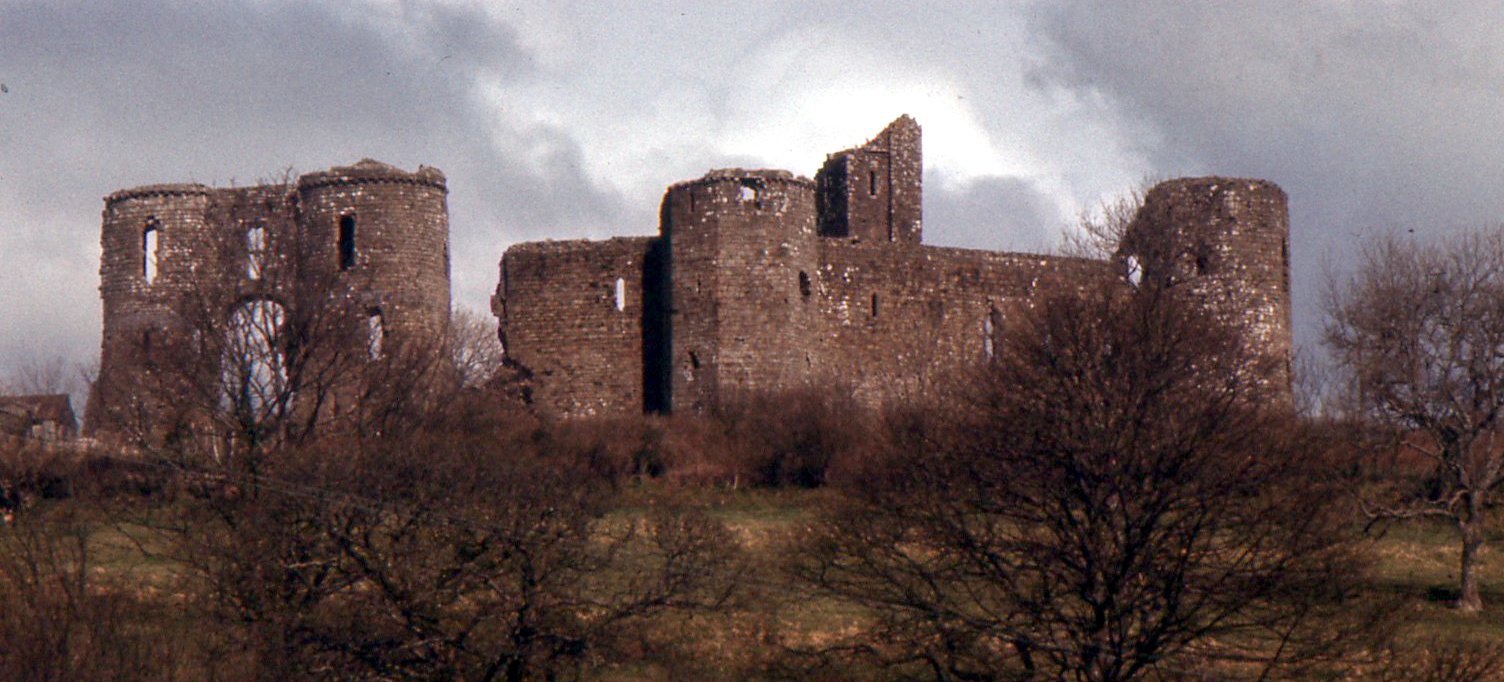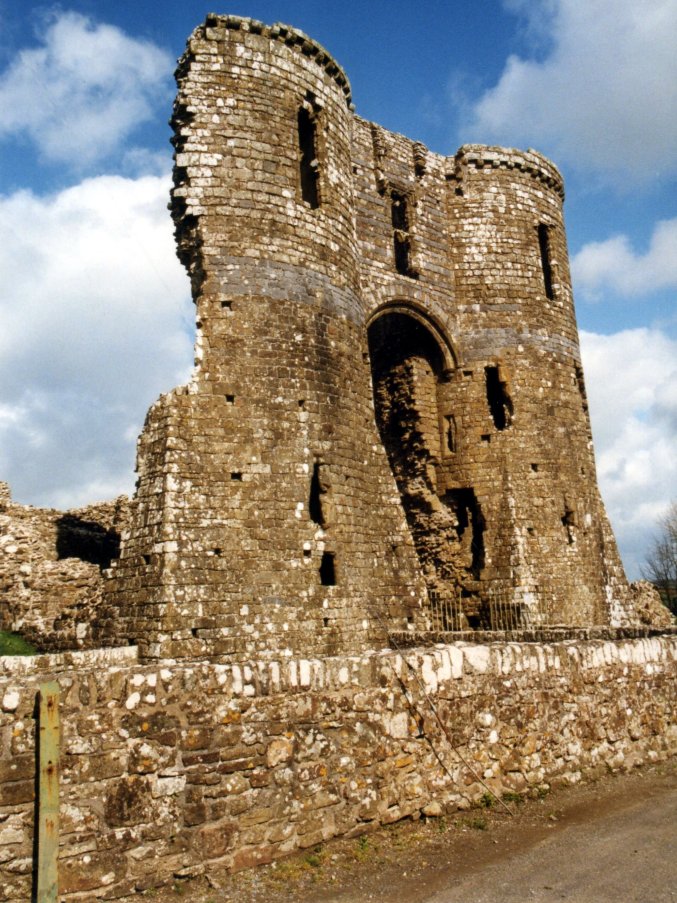Llawhaden

Early in 1192 Prince Rhys
ap Gruffydd (d.1197) of Deheubarth ‘captured
Llawhaden castle by force'. He then gave the castle to his
son, Hywel Saes (d.1204), who obviously fortified it, for the next year
the
Flemings and Normans of Pembroke, ‘attacked the castle of
Llawhaden which was within Hywel's power, but they could not take it
and so returned home in disgrace' although they did kill Tewdwr ap
Pret, a reputed son of Rhys ap Gruffydd, in the town. After
this the Welsh Annales
state:
The
same Hywel and Maelgwn ap Rhys (d.1230) destroyed Llawhaden castle;
because
they had heard that the Flemings and the French of Pembroke were coming
with a huge and well equipped body of men; with their approach the
Welsh were struck dumb with amazement and soon divided themselves into
three parts. One of these parts entered the half ruined town,
the second truly approached the church, not to make prayers, but rather
to beg for refuge, the third rather than having confidence in either
the church or the town, made for the protection of the woods where they
were attacked by the French in the manner of wolves. Nearly
sixty of these Welshmen were killed by the sword near
Rutuant.
Another chronicle states:
Hywel
Saes took Wiston (Gwis) castle by
cunning. The same
Hywel feeling that this citadel was by no means safe unless he
dispersed some of those who held their lands of it, consulted with his
brother, that is Maelgwn, and they united their armies and destroyed
Llawhaden (Lanhuwadein)
castle. When the Flemings discovered
this they assembled that day to restore the castle; at this unexpected
attack the men of the aforementioned brothers turned in flight with not
a little slaughter. But after only a little while the Welsh
grouped in one body at the said castle and decided to level it to the
ground.
With this the history of the castle fades into obscurity. It
is uncertain
when the castle was rebuilt, but it was possibly not until Llywelyn ab
Iorwerth's forces had been driven from the district after his death in
April 1240. Indeed, it may have been that the district
remained under Welsh control for another 20 years, for on 9 August
1259 ‘many Welshmen were killed at Llawhaden
(Lanhuadeyn/Lawaden).
It was therefore possibly only after Llywelyn ap
Gruffydd's forces had been decisively driven from South Wales in
1276/77 that Llawhaden castle was rebuilt. Certainly Bishop
Thomas
Bek (1280-93)
created the borough of Llawhaden, building a
hospital there in 1287. So it is possible that the castle lay
derelict for almost 90 years. However, the euphemism used by
the medieval chronicles of ‘levelling a castle to the
ground',
often meant no more than firing the wooden parts and leaving the bulk
of the masonry standing.
Work was undertaken on the castle during the episcopate of Adam
Houghton (1362-89) and in 1383 Constable John Fawle was
named as master of the castle works, which by this definition were
obviously ongoing. The castle became a prison in the
fifteenth century and was no longer used as an episcopal
residence. It was fortified against Glyndwr in 1402, but
allowed to decay after the Reformation. During this Bishop
William Barlow (1536-48) partially dismantled the castle, while Bishop
Richard Millbourne was given licence in 1616 to demolish the fortress,
though
it appears he never did. Instead the castle was left to
decay. In 1740 the Buck brothers engraved it with the
gatehouse parapets intact and the windows of the great hall surviving.
 Description.
Description.
The first castle would appear to have been a ringwork about 180' in
diameter with a ditch 65' wide and 25' deep. It may well have
been bow shaped with the flat end towards the north-east. Certainly
the
shape of the moat suggests this, but the ringwork itself has been much
altered by the later masonry hall block overlying this side.
Of the early castle only a fragment of curtain wall and the foundations
of two towers recovered by excavation remain. The curtain
fragment is butted against by the western fourteenth century gatetower
and overlain by the slightly earlier mess hall with its massive south-west
wall. The curtain probably joined with the round west tower
which is partially built into by the mess hall. This tower is
some 32' in diameter with walls 10' thick. As such it is
similar in size and position to the ‘keep' at
Llanstephan.
This may place it amongst the small round tower keeps that can be found in the
Marches and elsewhere.
At the northern corner of
the
original ward are the foundations of a solid round turret some 18'
across. Such turrets are rare in British castles, but other
examples can be found at Degannwy
and Pembridge.
This is the
extent of the surviving pieces of original masonry.
Traditionally these are dated to the early thirteenth century on the
grounds that all such structures were built then. The history
of the site would rather suggest they are the remains of the pre 1193
castle.
The next phase of the castle would appear to be the building of the
peculiar rectangular structure now behind the eastern gatetower and
projecting from the later curtain wall. Possibly this was
some form of gatetower of the original castle, or possibly the work of Bishop
Bek (1280-93).
The next major build seems to be the massively built
hall block on the north-east side of the enclosure. This pushes
aggressively down into the ditch, unlike the other fourteenth century
work. Possibly this was the work of Bishop Bek - if he
undertook any work here. The south and east fronts are covered
by a new curtain with two differing octagonal towers projecting boldly
from the curtain. They and the internal buildings are
reckoned to be the work of Bishop Houghton in the 1380s. The
skewed twin towered gatehouse is thought to have been added during the
Glyndwr disturbances when a garrison was placed in the castle in
1402. The fragmentary bakehouse to the west may be even later.
Why
not join me at other Lost Welsh Castles next Spring?
Please see the information on tours at Scholarly
Sojourns.
Copyright©2019
Paul Martin Remfry


 Description.
Description.